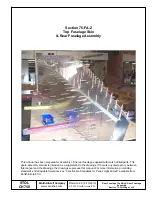
During the icing encounter the pneumatic de-ice boots will operate continuously in either 3min
or 1min cycle mode as selected by the aircrew. During this time the aircrew should frequently
monitor the continual shedding of ice from the wing leading edge and the airframe for ice
accretion on all visible surfaces that could affect aircraft controllability. It should be noted that
some residual ice will be maintained on the wing leading edge during cycling of the boots.
During the icing encounter continue to monitor the ICE PROTECTION window and the CAS
for correct function of the ice protection systems.
During flight in icing conditions the aircraft may be subject to a slight degradation in aircraft
performance and engine performance. This may be recognized by a required increase in
engine power to maintain a constant indicated airspeed and an increased engine ITT to
maintain a constant power respectively. If failure of any of the ice protection systems occurs
this degradation may become more severe. After such failure the pilot should make
immediate arrangements for departure of icing conditions as soon as practicable. If required
ATC priority assistance should be requested.
The emergency procedures, concerning failure of the ice protection systems during flight in
icing conditions, are provided in Section 3, Emergency Procedures,
On departure from icing conditions the inertial separator (INERT SEP) and the propeller deice
system (PROPELLER) should be kept OPEN and ON respectively until all visible and
unprotected areas of the aircraft are observed as being free of ice. This protects the engine
from possible ice ingestion and maintains the stick shaker/pusher computer in PUSHER ICE
MODE therefore protecting the aircraft against the onset of natural stall. The flaps are not to
be extended beyond 15° or in the case of deice boot failure, left at 0°. If the flaps are in an
extended position, do not retract them until the airframe is clear of ice.
If flaps are extended to positions that are not allowed, the CAS caption
Flaps EXT Limit
will be displayed and an aural gong will sound.
On departure of icing conditions the deice boots are to be selected OFF and the windshield
heat is to be selected as required for good visibility, irrespective of the presence of residual
ice.
Once all visible protected and unprotected areas are observed as being free of ice then the
inertial separator and the propeller deice system can be selected CLOSED and OFF
respectively. This will return the stick shaker/pusher computer to its normal mode. The flaps
can be extended or retracted to any required position.
When performing a landing approach after an icing encounter and with residual ice on the
airframe the minimum landing speeds defined above should be observed. This will prevent
stick shaker activation in PUSHER ICE MODE.
When performing a landing approach after an icing encounter and with residual ice on the
airframe the flap limitations defined above must be observed.
Section 4 - Normal Procedures (EASA Approved)
Flight in Icing Conditions
Pilot's Operating Handbook
Report No: 02406
Issue date: Mar 06, 2020
Page 4-24-4
12-C-A15-30-0424-00A-131A-A
FOR
GENERAL
AND
FAMILIARIZATION
PURPOSES
ONLY
















































